Speeches Shim
USAID Latin America and the Caribbean Final Hackathon Projects
USAID recently hosted a first-of-its-kind Open Data Hackathon, focusing on crime and violence in Latin America and the Caribbean. The event attracted over 100 participants from approximately 50 organizations worldwide. Participants formed teams based on skill sets and interests to create eight new projects, featured below, that illustrate how open data can provide new insights into crime in the region, as well as connect various USAID datasets to tell a story through newly cleaned and created APIs. Have your own ideas to share? Please see the Hackpad links below for opportunities to contribute!
Winning Project: Futures Group - Guatemala
Visualizations of Northern Triangle Perceptions of Crime and Violence
This winning project demonstrated the impact of violence in northern triangle countries. The team created simple but compelling visualizations of perceptions of crime and violence in the Northern Triangle using datasets from the Latin American Public Opinion Project (LAPOP). The group created images from the public opinion data to illustrate a visual story of Northern Triangle. They first show basic socio-demographic information and next examined what people in each of the countries perceived as their most vexing problems. To hone in on a solutions they showed the way people perceived violence in their neighborhood and showed who they most trusted.
Interested in furthering developing this project or sharing ideas? Join the discussion here.
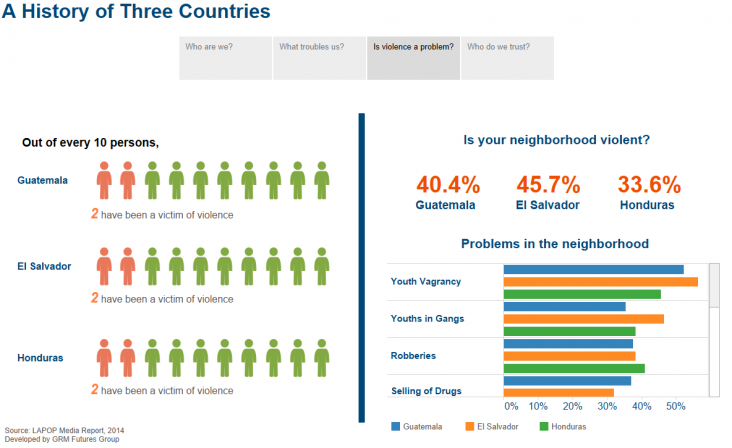
Social Media MappingThe social media mapping team analyzed the geo-location of real-time tweets in Latin America that had keywords pertaining to crime and violence over a span of 48 hours to understand what the populace was sharing publicly and at what times these issues were receiving the most attention. Did you know “violence” is mentioned most frequently and its greatest frequency is between the hours of 10pm and 2am? Interested in furthering developing this project or sharing ideas? Join the discussion here. |
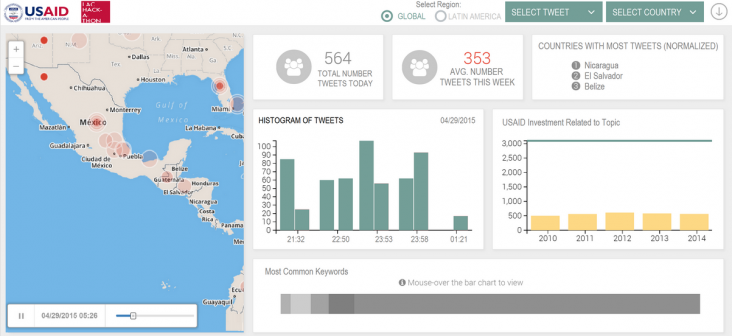 |
Real Estate Prices and CrimeThe Real Estate Prices and Crime team analyzed real estate pricing and its relation to crime and violence in Mexico. The team also explored the utility of Google trends as a form of data that is timelier than public opinion data and more structured than social media data. See their complete visualization and Hackpad for more information. Interested in furthering developing this project or sharing ideas? Join the discussion here. |
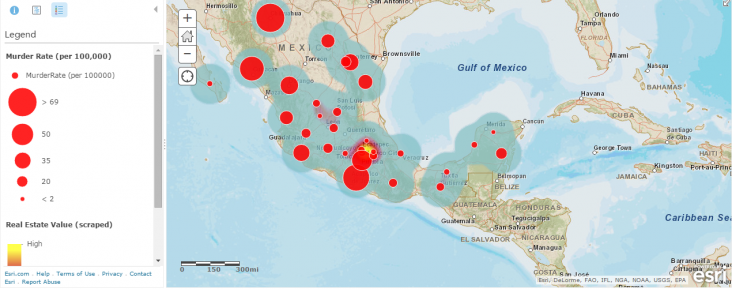 |
Crime Rates and USAID Project GeographyThis project explored security in Honduras by implementing different datasets to begin the process of informing users about different aspects of Honduras. Users of the visualization can navigate to the Security Map, which shows homicide rate per municipality, US Citizen deaths in Honduras, and USAID Projects locations. A correlation graphic showing that United States deportations of criminals correlate with homicide rates in Honduras. You can view the list of all datasets used on their visualization. Interested in furthering developing this project or sharing ideas? Join the discussion here. |
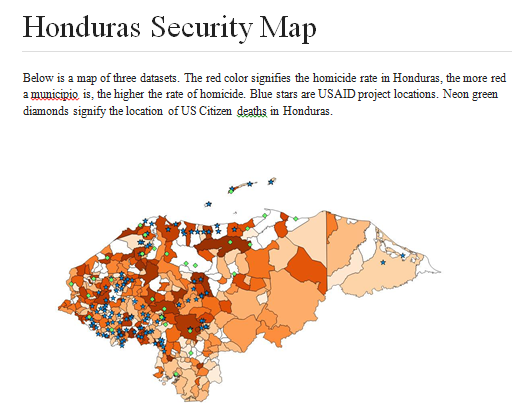 |
New Crime Metrics for Impact AnalysisThis project focused on trying to find a particular set of characteristics of USAID assistance in Latin American countries that made them effective (or not-effective) in reducing the crime rate. To do so the team collected all of the foreign assistance “Spending” data available from the past 10 years, retaining direct spending on peace and security, drug-enforcement initiatives, social welfare and quality of life improvement spending while pruning out spending for initiatives such as the promotion of democracy, etc. The team created a crime index that incorporated per capita statistics of violent, petty and semi-serious crime into an index. It turned out that according to the per capita spending and the crime statistics. Honduras, Mexico and Colombia were interesting case studies of the effectiveness of spending on crime. Please see their Hackpad for visualizations and a full explanation of this projects methodology. Interested in furthering developing this project or sharing ideas? Join the discussion here. |
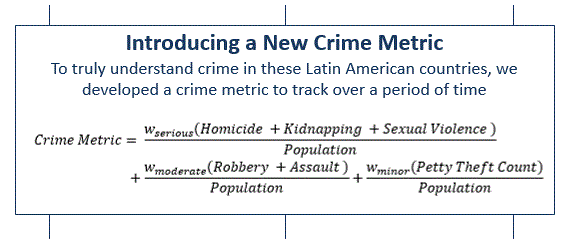 |
Public Opinion and Social Media DataThe next featured team examined correlations between the Latin America Public Opinion Project (LAPOP) data and perceptions in social media. The team analyzed different ways that social media could be used to understand public perception of the region in real time. See more of their work via their Hackpad. Interested in furthering developing this project or sharing ideas? Join the discussion here. |
 |
Mapping HondurasThis team mapped streets in Honduras and geocoded Latin American Public Opinion Project (LAPOP) projects. Interested in Mapping? Help Honduras with the locations listed on the Hackpad! Interested in furthering developing this project or sharing ideas? Join the discussion here. |
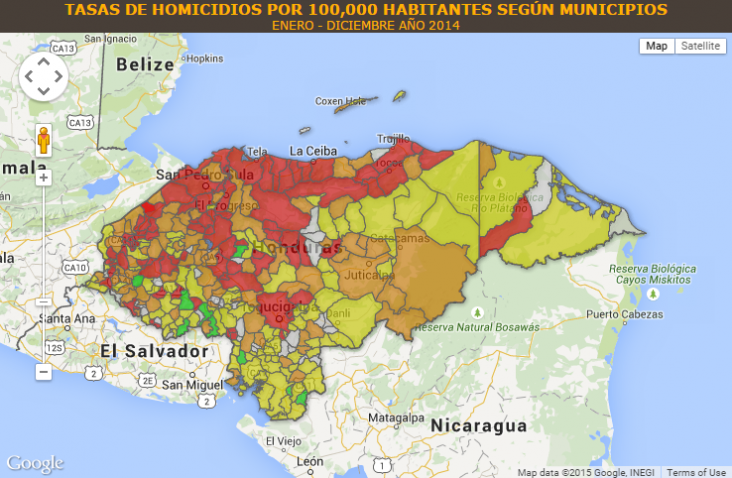 |
Donor Mapping Project and API EnhancementUsing USAID’s Development Experience Clearinghouse (DEC), Economic Analysis and Data Services, and the Foreign Assistance Dashboard, this team geo-located donor projects and enhanced and created new Application Programming Interfaces (APIs) for USAID public datasets. You can access more of their work via their Hackpad. Interested in furthering developing this project or sharing ideas? Join the discussion here. |
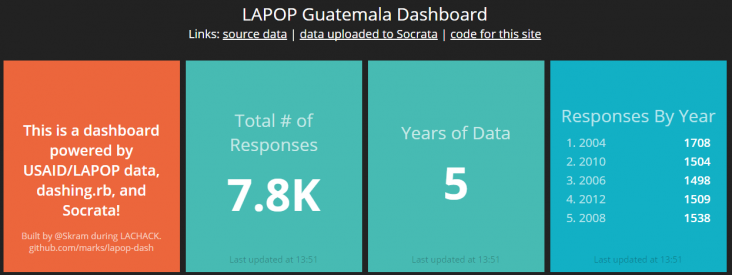 |
- Feel free to explore USAID's Development Data Library for other open USAID data.
- Sign up for USAID's open data communications listserv to find out more about new data opportunities as they arise.
- Join the conversation on Twitter using @USAIDLAC #OpenData #LACHack
- Contact the Open Data Team with any additional questions (opendata@usaid.gov) with additional questions or ideas.

Comment
Make a general inquiry or suggest an improvement.